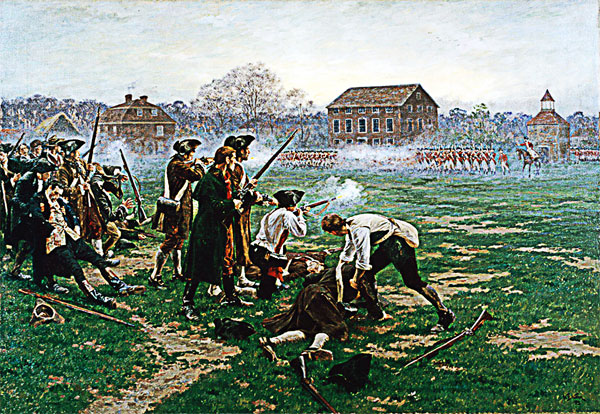
American Revolution begins at Battle of Lexington on April 19, 1775
American Revolution begins at Battle of Lexington: At about 5 a.m., 700 British troops, on a mission to capture Patriot leaders and seize a Patriot arsenal, march into Lexington to find 77 armed minutemen under Captain John Parker waiting for them on the town’s common green.
British Major John Pitcairn ordered the outnumbered Patriots to disperse, and after a moment’s hesitation the Americans began to drift off the green. Suddenly, a shot was fired from an undetermined gun, and a cloud of musket smoke soon covered the green. When the brief Battle of Lexington ended, eight Americans lay dead or dying and 10 others were wounded. Only one British soldier was injured, but the American Revolution had begun.
By 1775, tensions between the American colonies and the British government approached the breaking point, especially in Massachusetts, where Patriot leaders formed a shadow revolutionary government and trained militias to prepare for armed conflict with the British troops occupying Boston. In the spring of 1775, General Thomas Gage, the British governor of Massachusetts, received instructions from England to seize all stores of weapons and gunpowder accessible to the American insurgents.
On April 18, he ordered British troops to march against the Patriot arsenal at Concord and capture Patriot leaders Samuel Adams and John Hancock, known to be hiding at Lexington.
The Boston Patriots had been preparing for such a military action by the British for some time, and upon learning of the British plan, Patriots Paul Revere and William Dawes were ordered to set out to rouse the militiamen and warn Adams and Hancock. When the British troops arrived at Lexington, a group of militiamen were waiting. The Patriots were routed within minutes, but warfare had begun, leading to calls to arms across the Massachusetts countryside.

When the British troops reached Concord at about 7 a.m., they found themselves encircled by hundreds of armed Patriots. They managed to destroy the military supplies the Americans had collected but were soon advanced against by a gang of minutemen, who inflicted numerous casualties. Lieutenant Colonel Francis Smith, the overall commander of the British force, ordered his men to return to Boston without directly engaging the Americans. As the British retraced their 16-mile journey, their lines were constantly beset by Patriot marksmen firing at them Indian-style from behind trees, rocks, and stone walls.
At Lexington, Captain Parker’s militia had its revenge, killing several British soldiers as the Red Coats hastily marched through his town. By the time the British finally reached the safety of Boston, nearly 300 British soldiers had been killed, wounded, or were missing in action. The Patriots suffered fewer than 100 casualties.
The battles of Lexington and Concord were the first battles of the American Revolution, a conflict that would escalate from a colonial uprising into a world war that, seven years later, would give birth to the independent United States of America.
SEVEN Events That Led to the American Revolution
SIX Unsung Heroes of the American Revolution
History Channel / Wikipedia / Encyclopedia Britannica
Library Of Congress.gov / Museum of the American Revolution.org / National Archives.gov / U.S. History.org / American Battlefields.org /
American Revolution begins at Battle of Lexington on April 19, 1775 (YouTube) 
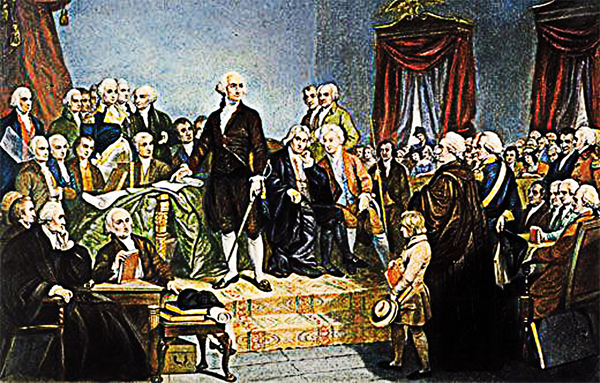
United States President George Washington exercises first presidential veto on April 05, 1792
United States President George Washington exercises first presidential veto: On April 5, 1792 - George Washington's veto of a Congressional bill introduced a new plan for dividing seats in the House of Representatives that would have increased the amount of seats for northern states.
After consulting with his politically divided and contentious cabinet, Washington, who came from the southern state of Virginia, ultimately decided that the plan was unconstitutional because, in providing for additional representatives for some states, it would have introduced a number of representatives higher than that proscribed by the Constitution.
After a discussion with the president, Thomas Jefferson wrote in a letter that votes for or against the bill were divided along perfectly geographical lines between the North and South. Jefferson observed that Washington feared that a veto would incorrectly portray him as biased toward the South.
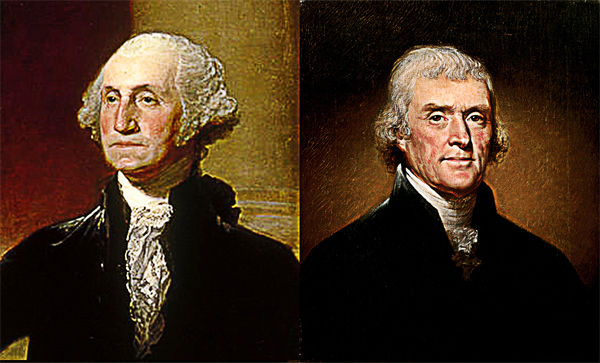
In the end, Jefferson was able to convince the president to veto the bill on the grounds that it was unconstitutional and introduced principles that were liable to be abused in the future. Jefferson suggested apportionment instead be derived from arithmetical operation, about which no two men can ever possibly differ.
“Washington’s veto sent the bill back to Congress. Though representatives could have attempted to overrule the veto with a two-thirds vote, Congress instead threw out the original bill and instituted a new one that apportioned representatives at “the ratio of one for every thirty-three thousand persons in the respective States.”
Washington exercised his veto power only one other time during his two terms in office. In February 1797, the former commanding general of the Continental Army vetoed an act that would have reduced the number of cavalry units in the army.
History Channel / Wikipedia / Encyclopedia Britannica
History, Art & Archives - United States House of Representatives.gov / Washington Papers.org / National Archives.gov / American Bar Association.org /
United States President George Washington exercises first presidential veto on April 05, 1792 (YouTube) 
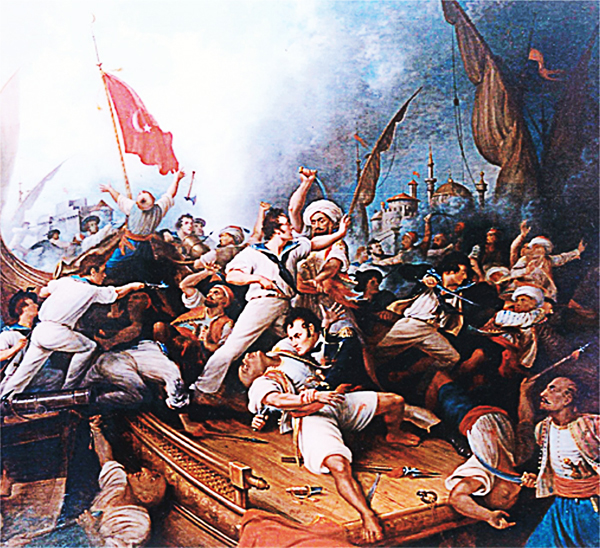
United States agent William Eaton a small force of U.S. Marines and Berber mercenaries “to the shores of Tripoli” on April 27, 1805
United States agent William Eaton a small force of U.S. Marines and Berber mercenaries “to the shores of Tripoli”: After marching 500 miles from Egypt, U.S. agent William Eaton leads a small force of U.S. Marines and Berber mercenaries against the Tripolitan port city of Derna.
The Marines and Berbers were on a mission to depose Yusuf Karamanli, the ruling pasha of Tripoli, who had seized power from his brother, Hamet Karamanli, a pasha who was sympathetic to the United States.
The First Barbary War had begun four years earlier, when U.S. President Thomas Jefferson ordered U.S. Navy vessels to the Mediterranean Sea in protest of continuing raids against U.S. ships by pirates from the Barbary states–Morocco, Algeria, Tunis, and Tripolitania.
American sailors were often abducted along with the captured booty and ransomed back to the United States at an exorbitant price.
After two years of minor confrontations, sustained action began in June 1803, when a small U.S. expeditionary force attacked Tripoli harbor in present-day Libya.
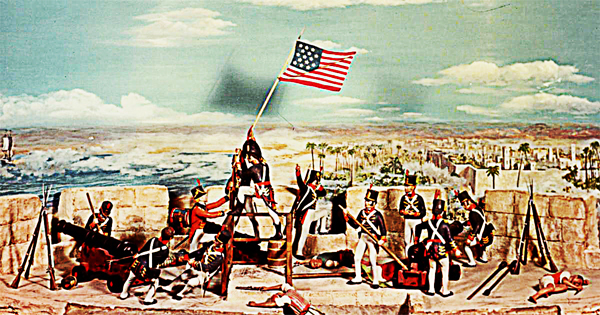
Battle of Derna: In April 1805, a major American victory came during the Derna campaign, which was undertaken by U.S. land forces in North Africa.
Supported by the heavy guns of the USS Argus and the USS Hornet, Marines and Arab mercenaries under William Eaton captured Derna and deposed Yusuf Karamanli. Lieutenant Presley O’ Bannon, commanding the Marines, performed so heroically in the battle that Hamet Karamanli presented him with an elaborately designed sword that now serves as the pattern for the swords carried by Marine officers.
The phrase “to the shores of Tripoli”, from the official song of the U.S. Marine Corps, also has its origins in the Derna campaign.
History Channel / Wikipedia / Encyclopedia Britannica
NAVY: Naval History and Heritage Command / Library Of Congress.gov / National Archives.gov / Monticello.org / Washington Papers.org /
United States agent William Eaton a small force of U.S. Marines and Berber mercenaries “to the shores of Tripoli” on April 27, 1805 (YouTube) 

American Civil War Civil War begins as Confederate forces fire on Fort Sumter on April 12, 1861
American Civil War Civil War begins as Confederate forces fire on Fort Sumter: On April 12, 1861, The bloodiest four years in American history begin when Confederate shore batteries under General P.G.T. Beauregard open fire on Union-held Fort Sumter in South Carolina’s Charleston Bay.
During the next 34 hours, 50 Confederate guns and mortars launched more than 4,000 rounds at the poorly supplied fort. On April 13, U.S. Major Robert Anderson surrendered the fort. Two days later, U.S. President Abraham Lincoln issued a proclamation calling for 75,000 volunteer soldiers to quell the Southern “insurrection”.
As early as 1858, the ongoing conflict between North and South over the issue of slavery had led Southern leadership to discuss a unified separation from the United States. By 1860, the majority of the slave states were publicly threatening secession if the Republicans, the anti-slavery party, won the presidency. Following Republican Abraham Lincoln’s victory over the divided Democratic Party in November 1860.
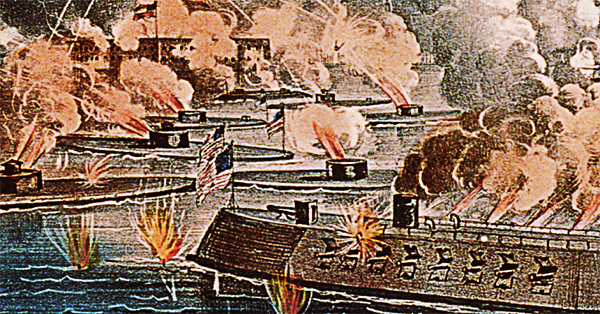
South Carolina immediately initiated secession proceedings. On December 20, the South Carolina legislature passed the “Ordinance of Secession”, which declared that “the Union now subsisting between South Carolina and other states, under the name of the United States of America, is hereby dissolved”. After the declaration, South Carolina set about seizing forts, arsenals, and other strategic locations within the state. Within six weeks, five more Southern states - Mississippi, Florida, Alabama, Georgia, and Louisiana–had followed South Carolina’s lead.
In February 1861, delegates from those states convened to establish a unified government. Jefferson Davis of Mississippi was subsequently elected the first president of the Confederate States of America. When Abraham Lincoln was inaugurated on March 4, 1861, a total of seven states (Texas had joined the pack) had seceded from the Union, and federal troops held only Fort Sumter in South Carolina, Fort Pickens off the Florida coast, and a handful of minor outposts in the South. Four years after the Confederate attack on Fort Sumter, the Confederacy was defeated at the total cost of 620,000 Union and Confederate soldiers dead.
History Channel / Wikipedia / Encyclopedia Britannica
American Battlefields.org / Library Of Congress.gov / National Archives.gov /National Geographic.org /
American Civil War Civil War begins as Confederate forces fire on Fort Sumter on April 12, 1861 (YouTube) 
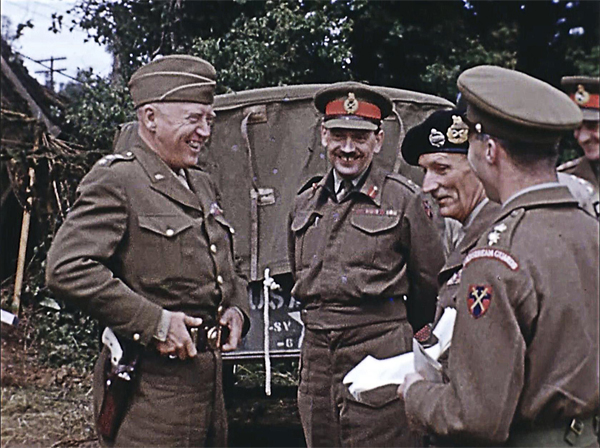
General George Patton takes Frankfurt on March 29, 1945
General George Patton takes Frankfurt: Genneral George S. Patton’s 3rd Army captures Frankfurt, as “Old Blood and Guts” continues his march east.
Frankfurt am Main, literally “On the Main” River, in western Germany, was the mid-19th century capital of Germany (it was annexed by Prussia in 1866, ending its status as a free city). Once integrated into a united German nation, it developed into a significant industrial city - and hence a prime target for Allied bombing during the war.
That bombing began as early as July 1941, during a series of British air raids against the Nazis. In March 1944, Frankfurt suffered extraordinary damage during a raid that saw 27,000 tons of bombs dropped on Germany in a single month. Consequently, Frankfurt’s medieval Old Town was virtually destroyed (although it would be rebuilt in the postwar period—replete with modern office buildings).
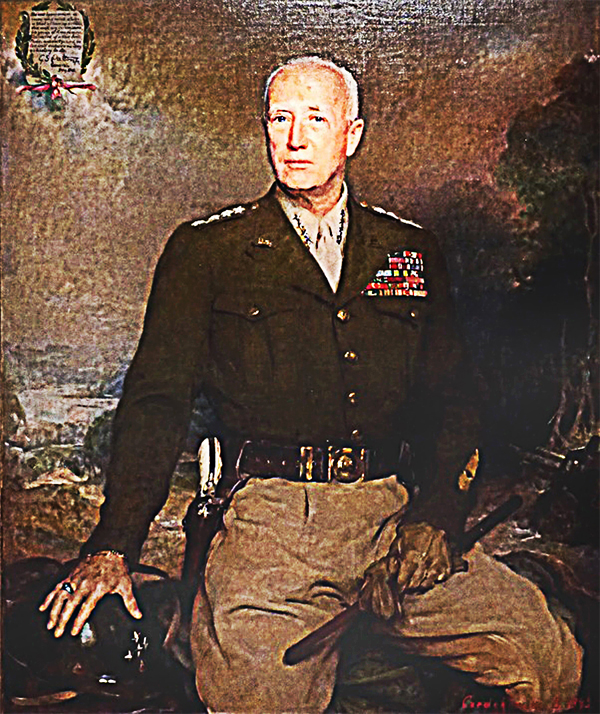
In late December 1944, during the Battle of the Bulge, General Patton broke through the German lines of the besieged Belgian city of Bastogne, relieving its valiant defenders.
Patton then pushed the Germans east. Patton’s goal was to cross the Rhine, even if not a single bridge was left standing over which to do it. As Patton reached the banks of the river on March 22, 1945, he found that one bridge—the Ludendorff Bridge, located in the little town of Remagen—had not been destroyed.
American troops had already made a crossing on March 7—a signal moment in the war and in history, as an enemy army had not crossed the Rhine since Napoleon accomplished the feat in 1805. Patton grandly made his crossing, and from the bridgehead created there, “Old Blood and Guts” and his 3rd Army headed east and captured Frankfurt on the 29th.
History Channel / Wikipedia / Encyclopedia Britannica
Library Of Congress / Soldiers Walk Memorial Park / Virginia Memorial Institute.edu /
General George Patton takes Frankfurt on March 29, 1945 (YouTube) 
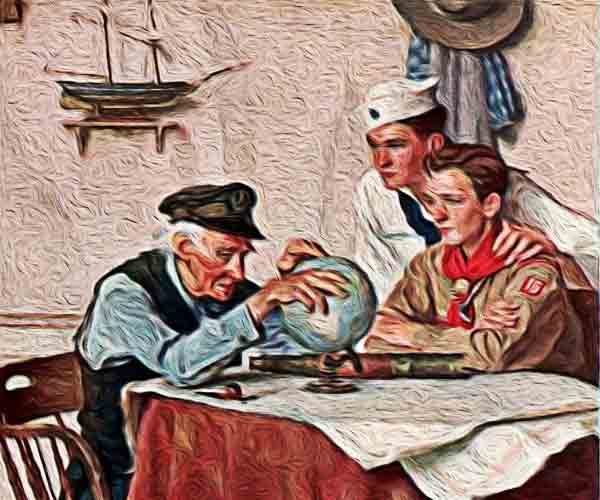
Understanding Military Terminology
Recovery
(DOD)
1. In air (aviation) operations, that phase of a mission that involves the return of an aircraft to a land base or platform afloat. (JP 3-52)
2. The retrieval of a mine from the location where emplaced. (JP 3-15)
3. In personnel recovery, actions taken to physically gain custody of isolated personnel and return them to friendly control. (JP 3-50)
4. Actions taken to extricate damaged or disabled equipment for return to friendly control or repair at another location (JP 3-34)
See also Evader; Evasion.
Joint Publications (JP 3-34) Joint Airspace Control - Intelligence Resource Program
Recovery and Reconstitution
(DOD)
1. Those actions taken by one nation prior to, during, and following an attack by an enemy nation to minimize the effects of the attack, rehabilitate the national economy, provide for the welfare of the populace, and maximize the combat potential of remaining forces and supporting activities.
2. Those actions taken by a military force during or after operational employment to restore its combat capability to full operational readiness.
See also Recovery.
Joint Publications (JP 3-35) Deployment and Redeployment Operations
Recovery Mechanism
(DOD) An indigenous or surrogate infrastructure that is specifically developed, trained, and directed by United States forces to contact, authenticate, support, move, and exfiltrate designated isolated personnel from uncertain or hostile areas back to friendly control.
Also called RM.
Joint Publications (JP 3-50) Personnel Recovery
Recovery Operations
(DOD) Operations conducted to search for, locate, identify, recover, and return isolated personnel, human remains, sensitive equipment, or items critical to national security.
Joint Publications (JP 3-50) Personnel Recovery
Recovery Site
(DOD) In personnel recovery, an area from which isolated personnel can be recovered.
Also called Escapee; Evader; Evasion.
Joint Publications (JP 3-50) Personnel Recovery
Recovery Team
(DOD) In personnel recovery, designated United States or United States-directed forces, that are specifically trained to operate in conjunction with indigenous or surrogate forces, and are tasked to contact, authenticate, support, move, and exfiltrate isolated personnel.
Also called RT.
Joint Publications (JP 3-50) Personnel Recovery
Recovery Vehicle
(DOD) In personnel recovery, the vehicle on which isolated personnel are boarded and transported from the recovery site.
Joint Publications (JP 3-50) Personnel Recovery
Joint Publication - Department of Defense Dictionary of Military and Associated Terms
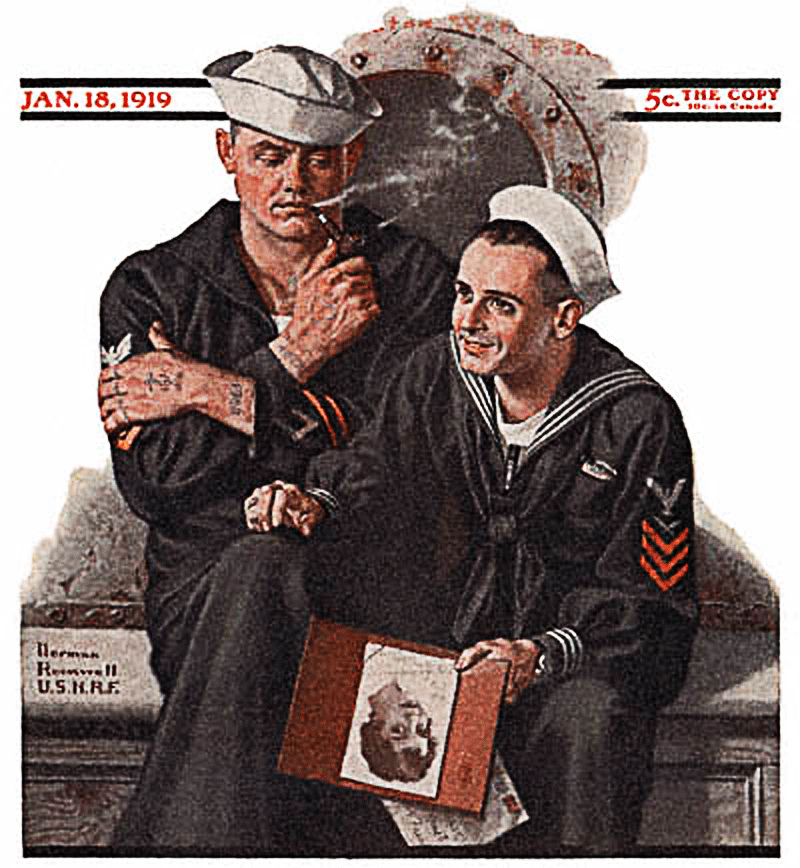
The Old Salt’s Corner
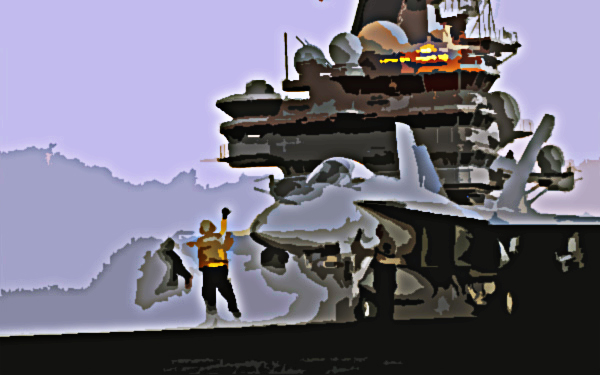
“THE HOLE”
Now each of us from time to time, has gazed upon the sea
And watched the warships pulling out, to keep this country free.
And most of us have read a book, or heard a lusty tale,
About the men who sail these ships, through lightning, wind and hail.
AND MOST OF U But there’s a place within each ship, that legend fails to teach.
It’s down below the waterline, it takes a living toll -
A hot metal living hell, that sailors call the “hole”.
It houses engines run by steam, that makes the shafts go round,
A place of fire and noise and heat, that beats your spirit down,
Are of molded gods without remorse, are nightmares in a dream.
Whose threat that from the fires roar, is like living doubt,
That any minute would with scorn, escape and crush you out.
Where turbines scream like tortured souls, alone and lost in hell,
As ordered from above somewhere, they answer every bell.
The men who keep the fires lit, and make the engines run,
Are strangers to the world of night, and rarely see the sun.
They have no time for man or God, no tolerance for fear,
Their aspect pays no living thing, the tribute of a tear.
For there’s not much that men can do, that these men haven’t done,
Beneath the decks deep in the hole, to make the engines run.
And every hour of every day, they keep the watch in hell,
For if the fires ever fail, their ship’s a useless shell.
When ships converge to have a war, upon the sea,
The men below just grimly smile, at what their fate might be.
They’re locked in below like men for doomed, who hear no battle cry,
It’s well assumed that if they’re hit, the men below will die.
For every day’s a war down there, when the gauges all read red,
Twelve hundred pounds of heated steam, can kill you mighty dead.
So if you ever write their sons, or try to tell their tale,
The very words would make you hear, a fired furnace’s wail.
And people as a general rule, don’t hear of men of steel,
So little’s heard about the place, that sailors call the “hole”.
But I can sing about this place, and try to make you see,
The hardened life of men down there, cause one of them is me.
I’ve seen these sweat soaked heroes fight, in superheated air,
To keep their ship alive and right through no one knows they’re there.
And thus they’ll fight for ages on, till warships sail no more,
Amid the boiler’s mighty heat, and the turbines hellish roar.
So when you see a ship pull out, to meet a warlike foe,
Remember faintly if you can, “THE MEN WHO SAIL BELOW”.
~ Author unknown

“I’m Just Sayin”
“The noir hero is a knight in blood caked armor. He's dirty and he does his best to deny the fact that he's a hero the whole time.”
“Sometimes the solitary voice can be the best one.”
“Cartoonists' dirty secret is that we tend to come up with stories that involve things that are really fun to draw.”
“Occupy” is nothing but a pack of louts, thieves, and rapists, an unruly mob,
fed by Woodstock-era nostalgia and putrid false righteousness.
These clowns can do nothing but harm America.”
“You can't have virtue without sin.
What I'm after is having my characters' virtues defined by how they operate in a very sinful environment.
That's how you test people.”
“I'm a mirror.
If you're cool with me, I'm cool with you,
and the exchange starts.
What you see is what you reflect.
If you don't like what you see,
then you've done something.
If I'm standoffish, that's because you are.”
~ Frank Miller

“Thought for the Day”
“The duty of youth is to challenge corruption.”
“Wanting to be someone else is a waste of the person you are.”
“I'm not well-read, but when I read, I read well.”
“I'm so happy because today I found my friends,
they're in my head.”
“I'd rather be hated for who I am,
than loved for who I am not.”
“Drugs are a waste of time.
They destroy your memory and your self-respect and everything that goes along with with your self-esteem.
They're no good at all.”
~ Kurt Cobain

“What I Learned”
“Where is all the knowledge we lost with information?”
“Only those who will risk going too far can possibly find out how far one can go.”
“I will show you fear in a handful of dust.”
“”
“The communication of the dead is tongued with fire beyond the language of the living.”
“The last temptation is the greatest treason:
to do the right deed for the wrong reason.”
“I don't believe one grows older.
I think that what happens early on in life is that at a certain age one stands still and stagnates.”
“If you aren't in over your head,
how do you know how tall you are?”
“This is the way the world ends,
not with a bang,
but a whimper.”
“What we call the beginning is often the end.
And to make an end is to make a beginning.
The end is where we start from.”
~ T. S. Eliot
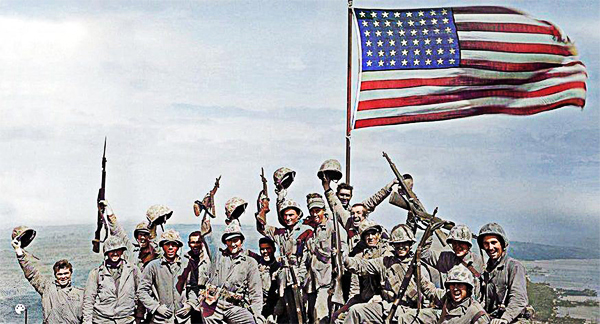 Mr. Answer Man Please Tell Us: Why Are Marines Called ”Jarheads”?
Mr. Answer Man Please Tell Us: Why Are Marines Called ”Jarheads”?
You’ve probably heard the term jarhead even if you’re not part of the military. It’s a common term for someone in the Marines that emerged around World War II. There are a few theories surrounding where this term came from and why Marines are called jarheads but today, it’s mostly used as a beloved term used by the Marines, encouraging a sense of camaraderie.
Who are the Marines?
The U.S. Marine Corps was founded on November 10, 1774, and is responsible for conducting “expeditionary and amphibious operations.” Originally, they were subset groups of the three other main military branches – the Army, Navy, and Air Force and became a component of the U.S. Navy in 1834. Now, the Marines are considered their own branch of the U.S. military.
The Marine Corps began in Philadelphia fighting at sea and onshore as a part of the infantry. In the Pacific during World War II, the Marines took the lead even though they are the smallest of the eight U.S. military branches.
Basic training for Marine recruits lasts 13 weeks, making it the longest initial training process in the military, before completing further intensive training which lasts for various periods of time.
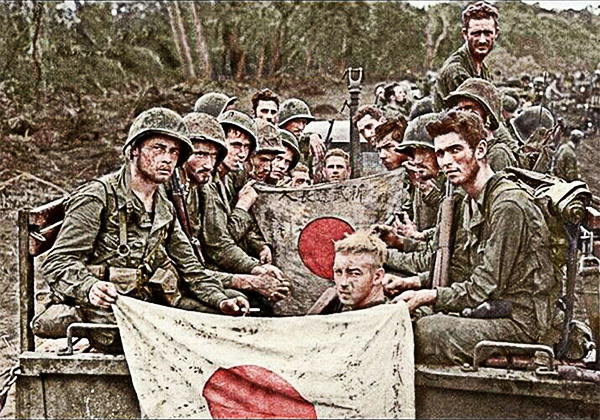
Some say “Jarhead” originated from the Marine uniform.
The first theory about where jarhead came from refers to the Marine uniform. Their uniforms haven’t changed much over the years and are the most stable and recognizable uniform in all of the U.S. military
The dress blues date back to the early 19th century and the service uniform came about in the early 20th century. The uniforms are also unique in that they don’t often present obvious distinctions such as pins or insignias.
For example, an Army Ranger or Navy SEAL has specific insignia to separate them from the rest of the branch and these subsets are often more proud of these distinctions than the larger branch they are technically a part of. In the Marines, there are only a handful of skills that warrant distinguishing pins.
In short, a Marine is a Marine and there’s a strong sense of brotherhood there, no matter what special skills you possess.
So, how does jarhead relate to a Marine’s uniform? Well, it’s all about the collar.
Marines had a prominent leather collar that earned them the nickname of “Leatherbacks”. Although the leather collar is no longer present in the current uniforms, the collar is still rather high, especially on the dress blues.
This theory argues that the high collar makes the Marine’s head, while in uniform, look as if it is coming out of a jar. Hence the term jarhead.
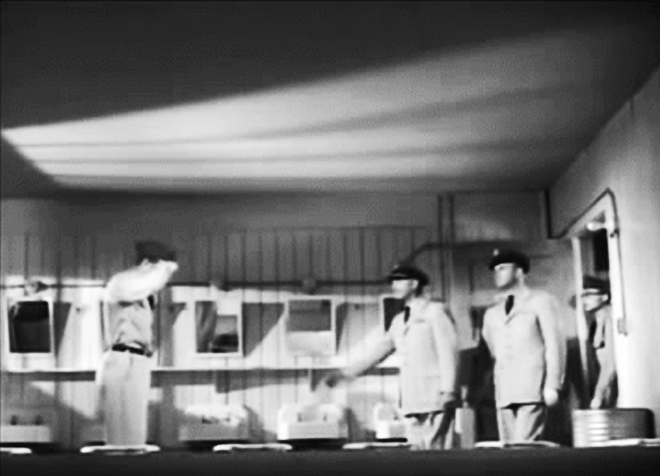
Others say “Jarhead” came from the Marine haircut.
The Marine haircut is known as the “high and tight” and it’s a version of the classic military crew cut. It’s characterized by a very short buzz cut on the sides and a tall, almost square look with the longer hair on top.
Therefore, the term jarhead could’ve come from the fact that a Marine’s haircut looked like the cap of a jar which spawned the nickname for their heads.
Some say it has nothing to do with uniforms or haircuts but comes from a more abstract place.
It’s common among non-Marines in the military to stereotype Marines as “drinking the Kool-aid” while being a bit hard-headed and susceptible to brainwashing. Therefore, some theories suggest that jarhead is another permutation of this concept.
By calling a Marine a jarhead, this theory holds that a Marine has an empty jar for a head – hard on the outside, empty on the inside, and ready to be filled with military propaganda.
Others who agree with this theory but take a less critical approach claim that this “hard on the outside, empty on the inside” idea makes an ideal soldier. Perhaps this is why many Marines don’t see the term jarhead as derogatory. In another sense, a jarhead is willing to single-mindedly follow orders straight into battle no matter how dangerous it may be. Basically, Marines are known for putting their duty to their country above their own personal safety.
According to this theory, being a jarhead means going against human nature and sacrificing yourself regardless of what your instincts might be saying.
Yet another theory claims “Jarhead” came about due to the Mason Jar company making steel helmets for the Marines.
Although this theory is perhaps far-fetched, the final explanation for why Marines are called jarheads has to do with old school helmets made by the same company that produced Mason Jars. Apparently, these helmets were produced during World War II and the nickname caught on during those years.
Overall, it’s still uncertain why Marines are called jarheads and the argument continues.
Our Military / Wikipedia / U.S. Department Of Defense.gov /
USMC Press / Mental Floss / Quora /
Why Are Marines Called ”Jarheads”? (YouTube) 

NAVSPEAK aka U.S. Navy Slang
Tweek and Peak: To fine tune something (uniform, rack, hair, etc); usually for inspection preparation.
Tweeker:
(1) (Submarine Service) An electronics rating; any engineering rating not gronking a wrench. (Rarely applied to rates such as ET and AT who “tweek” electronic components to make them work again.)
(2) (Aviation) An AT who spends most of his time complaing about how cold it is in the AIMD tunnel to those that work in open air spaces in or around the desert.
Tweener: (Submarine Service): Affectionate term for Missile Technicians on Ballistic Missile Submarines. Usually called out during the “Coner” and “Nuke” throwbacks, since the Missile Compartment is “between” the Forward (Coner) and Engineering (Nuke) spaces.
Twidget: Sailor in the Electronics or Electrical fields of job specialties.
Twig: Medical Service Corps officer. So named for the slanting stem attached to their device.
Two-block: To have all the work one can handle. Derived from when the blocks on a block and tackle are together and can not lift any higher. “My guys are two-blocked”.
Two-Digit Midget: Sailor with 99 or less days until his/her “End of Active Obligated Service” (EAOS).
Tubes (Submarine Service): (Nickname for) the senior torpedoman (now MM-Weapons) onboard. This individual is in charge of the torpedoes and the torpedo tubes, hence the name.
Tuna Boat: A sub tender or other non-combat ship that is crewed primarily by female sailors.
See also “Love Boat”. “We're going to have great liberty this port: A tuna boat just pulled in!”
Turn “N” Burn: “Hurry up! Let's get going!” The term alludes to the practice of bombers over enemy territory turning after they have dropped their bombs and igniting their afterburners so as to exit hostile territory more quickly.
TWAT: (Old term for) a TWT.
TWT: Traveling Wave Tube Amplifier: A component used in DECM/ECM equipment.
Tweak: n Aviation Electronics Technician or AT.
Wiktionary.org

Just for you MARINE
Two-block: Hoist a flag or pennant to the peak, truck, or yardarm of a staff; or a tie with the knot positioned exactly in the gap of a collar of a buttoned shirt. Correctly, “to-block”—hoisted all the way to the block (pulley) at the top of signal halliard.
Two-digit Midget: An enlisted Marine with 99 or fewer days remaining on his or her enlistment or tour of duty. A variation is the single-digit midget, with nine or fewer days remaining.;
Wikipedia.org
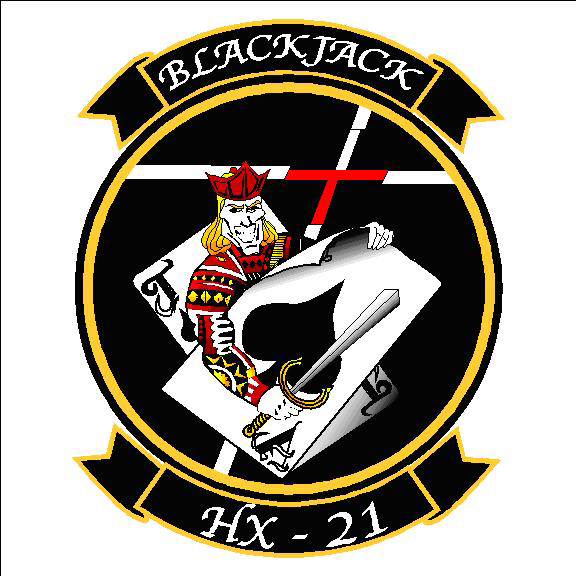
Naval Aviation Squadron Nicknames
HX-21 Air Test and Evaluation (HX) Squadron TWO ONE - nicknamed the “Blackjack”
United States Navy - Naval Air Systems Command (NAVAIRSYSCOM) Helicopter Test and Evaluation - Naval Air Station Patuxent River St. Mary’s County, Maryland, on the Chesapeake Bay near the mouth of the Patuxent River. / HT-28: November 1, 2006 - present
Wikipedia.org

Where Did That Saying Come From?

“A miss is as good as a mile:”
Meaning: A narrow miss is as bad as a wide miss - they are both misses.
History: This proverbial saying dates from the 18th century. The first example of it that I can find in print is from the USA, in the journal The American Museum, Volume 3, 1788:
“A smart repartee... will carry you through with eclat such as, ‘a miss is as good as a mile’.”
“A smart repartee... will carry you through with eclat such as, ‘a miss is as good as a mile’.”
The expression may or may not be American in origin, but the root source is certainly the British Isles. Similar expressions were in circulation there more than a century earlier; for example, this piece from William Camden's “Remaines of a Greater Worke Concerning Britaine”, 1605:
“An ynche in a misse is as good as an ell.”
[An ell is a now obsolete English measure of length, equalling about 45 inches.]
Camden's version is clearly essentially the same phrase as “a miss is as good as a mile”, the dimensions being those of the early 17th century. The expression was also considered proverbial in Scotland by the 18th century, where James Kelly included it in “A Complete Collection of Scotish Proverbs”, 1721:
“An Inch of a miss is as good as a span.”
Kelly wrote “span” as “spaw”, but it is clear what he meant - a span is the distance from the tip of the thumb to the tip of the little finger of a man's hand, usually formalised as 9 inches.
Perhaps more recent changes in dimensions will lead us to “a miss is as good as a kilometre”. Until then, we will have to make do with the American “close but no cigar”.
Phrases.org.uk

Science & Technology

FEATURED: High-speed propeller star is fastest spinning confirmed white dwarf
• Mystery of high performing novel solar cell materials revealed in stunning clarity
How sugar-loving microbes could help power future cars
• KPD 0005+5106: Roasted and shredded by a stellar sidekick
• Researchers make ultra-sensitive cancer detector from 2D materials
Researchers reveal how to turn a global warming liability into a profitable food security solution
• Astronomers detect a black hole in NGC 1850
• Deleting dysfunctional cells alleviates diabetes
Closing in on a new test for schistosomiasis
• Study of twins finds type 2 diabetes clues in epigenetic changes
• Feast or forage: Study finds circuit that helps a brain decide
Phys.org / MedicalXpress / TechXplore

FEATURED: Microwave observations reveal the deep extent and structure of Jupiter’s atmospheric vortices
• Protection against autoimmunity is driven by thymic epithelial cell–mediated regulation of Treg development
Europe’s space agency dreams of launching its own astronauts amid ambitious ‘Accelerator’ plans
• Controversial Berlin law gives postdocs pathway to permanent jobs
Chemical emitted by babies could make men more docile, women more aggressive
• How to hug, according to science
Satellites offer new ways to study ecosystems—and maybe even save them
• Dissecting the early COVID-19 cases in Wuhan
Science AAAS

Bizarre News (we couldn’t make up stuff this good - real news story)
Nuclear-powered U.S. submarine collided with a hidden underwater mountain, Navy reveals
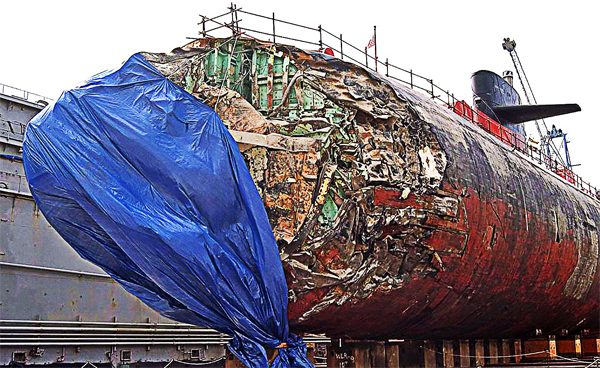
Around a dozen crewmembers were injured in the incident.
A nuclear-powered U.S. submarine that ran aground in the South China Sea last month collided with an uncharted seamount, according to a U.S. Navy investigation.
The USS Connecticut, a Seawolf-class fast-attack submarine, collided with an unknown object in international waters on Oct. 2, causing minor to moderate injuries to 11 crewmembers, NPR reported.
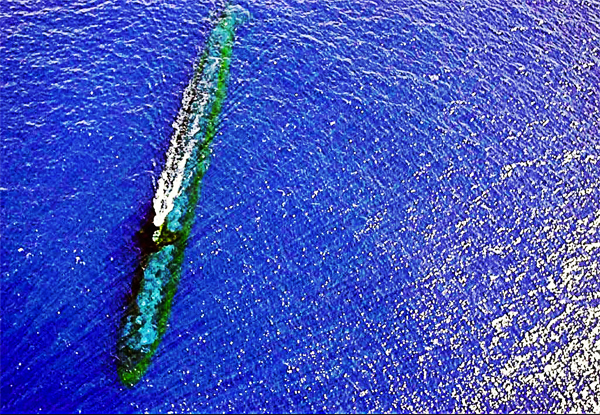
The damaged submarine surfaced and made it to a port in Guam unassisted. The Navy hasn't disclosed the full extent of the damage, and all the Navy said about the incident at the time was that “it was not another submarine” that had collided with the vessel, The Associated Press reported.
But the new report, released by the U.S. 7th Fleet on November 1, has “determined that Connecticut grounded on an uncharted seamount”.
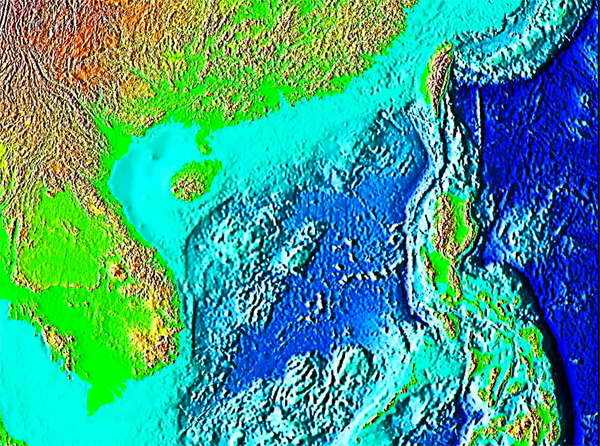
Seamounts, or underwater mountains, are remnants of extinct underwater volcanoes. A majority of seamounts are cone-shaped, but some - known as guyots - have large, flat summits. Seamounts are biological hotspots for marine life because their steep sides encourage the upwelling of nutrients from the deep sea and provide a place for sessile organisms, like corals and sponges, to settle and grow, according to the National Oceanic and Atmospheric Administration (NOAA).
More than 100,000 seamounts of at least 3,281 feet (1,000 meters) may dot the ocean floor, but scientists have mapped less than 0.1% of them, according to NOAA
In 2005, the USS San Francisco, another nuclear-powered attack submarine, hit an uncharted seamount in Guam at a top speed of 30 knots (34.5 miles per hour), which injured almost all of the 137-person crew and killed one, according to Popular Mechanics.
Related: The 20 most mysterious shipwrecks ever
24 underwater drones: The boom in robotics beneath the waves
Secret spies, sunken ships: 9 Pearl Harbor mysteries explained
7 technologies that transformed warfare
Live Science (11/03/2021) 


SONG FACTS
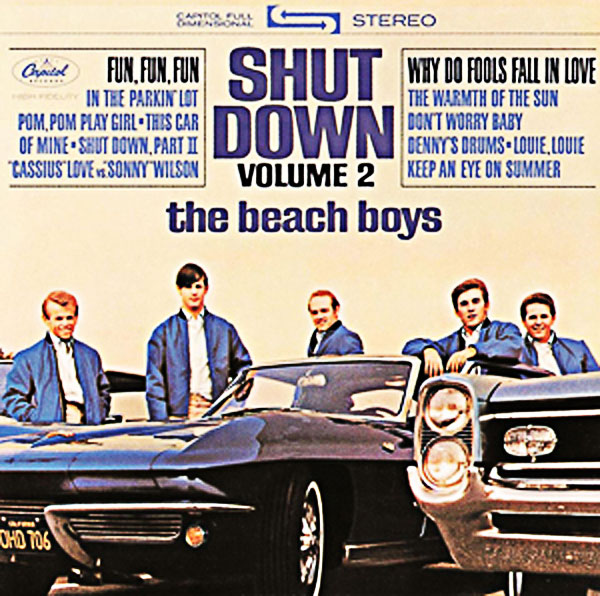
“Don't Worry Baby”  - The Beach Boys
- The Beach Boys
Album: Shut Down, Volume 2
Released 1964 
“Don't Worry Baby”  was conceived as a followup to The Ronettes' #2 hit
“Be My Baby”
was conceived as a followup to The Ronettes' #2 hit
“Be My Baby”  ;. When he heard The Ronettes' song on the radio, Brian Wilson wondered aloud if he could match it. Wilson's wife Marilyn reassured him, saying, “Don't worry, baby”.
Wilson remembered it when it came time to write songs with his DJ friend Roger Christian.
;. When he heard The Ronettes' song on the radio, Brian Wilson wondered aloud if he could match it. Wilson's wife Marilyn reassured him, saying, “Don't worry, baby”.
Wilson remembered it when it came time to write songs with his DJ friend Roger Christian.
Brian Wilson told Goldmine in 2011 regarding this track:
“I wrote that with Roger Christian and it took me two days to write it. I started out with the verse idea and then wrote the chorus. It was a very simple and beautiful song. It's a really heart and soul song, I really did feel that in my heart. Some say it's about a car and others say it's about a girl, who's right? It's both. It's about a car and a woman.”
Philip Lambert, author of Inside The Music of Brian Wilson, said of the similarities between this song and
“Be My Baby”  :
:
“They're in the same key - E Major - and they start the same. The phrase structure is the same, the chord progressions are almost the same, the melodies are almost the same.” Lambert points out that the key change in this song is an unexpected touch that helps make the song memorable.
The drums at the beginning are the same rhythm as “Be My Baby”.
“Don't Worry Baby”  was recorded in two 8-hour sessions. Brian Wilson often used the famous Los Angeles session musicians on his songs, but this one was mostly in the family: Brian played piano and bass, Carl Wilson played guitar, and Dennis Wilson played the drums.
was recorded in two 8-hour sessions. Brian Wilson often used the famous Los Angeles session musicians on his songs, but this one was mostly in the family: Brian played piano and bass, Carl Wilson played guitar, and Dennis Wilson played the drums.
The Beach Boys issued
“Don't Worry Baby”  as a single with
“I Get Around”
as a single with
“I Get Around”  , which was a #1 hit for the group.
, which was a #1 hit for the group.
B.J. Thomas covered this in 1977. His version hit #17 in the U.S.
This song was used in the Drew Barrymore film “Never Been Kissed”. It also appeared in “Good Morning Vietnam”
Billy Joel sang this at the “Tribute to Brian Wilson” concert that aired on July 4, 2001.
Weezer frontman Rivers Cuomo covered this in 1993. Fifteen years later he included his version on his solo Alone II album. He told Billboard magazine that this song was immensely influential on his songwriting. Cuomo explained:
“I discovered The Beach Boys around that time in 1992-93, and to help me learn how to write those kinds of melodies and harmonies and chord progressions, I would learn their songs and record my own versions of them more like Weezer-style, with distorted guitars.”
Cuomo added: “I love Brian Wilson's melody when he's saying, 'Well, it's been building up inside of me for oh, I don't know how long.' I love the lyrical innocence. It's just like a straightforward pop song, singing about a girl as opposed to something like the Pixies, where the lyrics were pretty abstract”
”And I love the big harmonies in the chorus - actually five-part vocal harmonies - and I carefully transcribed them in my bedroom on my tape player. But then I added the element of the modern crunchy guitar sound. And that's what really helped me figure out what I wanted to do as a songwriter and a performer in Weezer.”
Al Jardine told Mojo magazine June 2012 that this was his favorite Beach Boys recording session. He recalled:
“Engineer) Chuck Britz got such a great sound on that song; the drums, the singing, the clicky sound on the Fender Precision bass. There's something about the way the track sat. Just about everything about it was an era-change for us.”
MORE SONGS
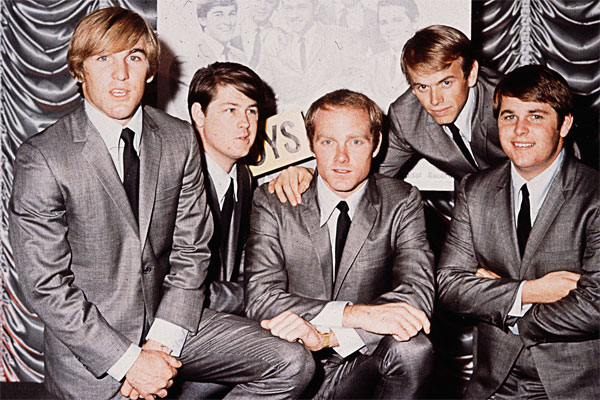
“Surfin” (1961) 
“409” (1962) 
“Surfin' Safari” (1962) 
“In My Room” (1963) 
“Be True To Your School” (1963) 
“Little Deuce Coupe” (1963) 
“Little Saint Nick” (1963) 
“Surfer Girl” (1963) 
“Surfer Girl” (1963) 
“Don't Worry Baby” (1964) 
“Fun Fun Fun” (1964) 
“I Get Around” (1964) 
“When I Grow Up (To Be a Man)” (1964) 
“California Girls” (1965) 
“Barbara Ann” (1965) 
“Help Me, Rhonda” (1965) 
“God Only Knows” (1966) 
“Good Vibrations” (1966) 
“Sloop John B” (1966) 
“Wouldn't It Be Nice” (1966) 
“Caroline, No” (1966) 
“I Can Hear Music” (1969) 
“Surf's Up” (1971) 
“Sail On Sailor” (1973) 
“Kokomo” (1988) 
The Beach Boys official site (The Beach Boys Discography) / Rock & Roll Hall of Fame / Billboard / All Music / Song Facts /
Ultimate Classic Rock / The Beach Boys
Image: “Shut Down, Volume 2 (album)” by The Beach Boys
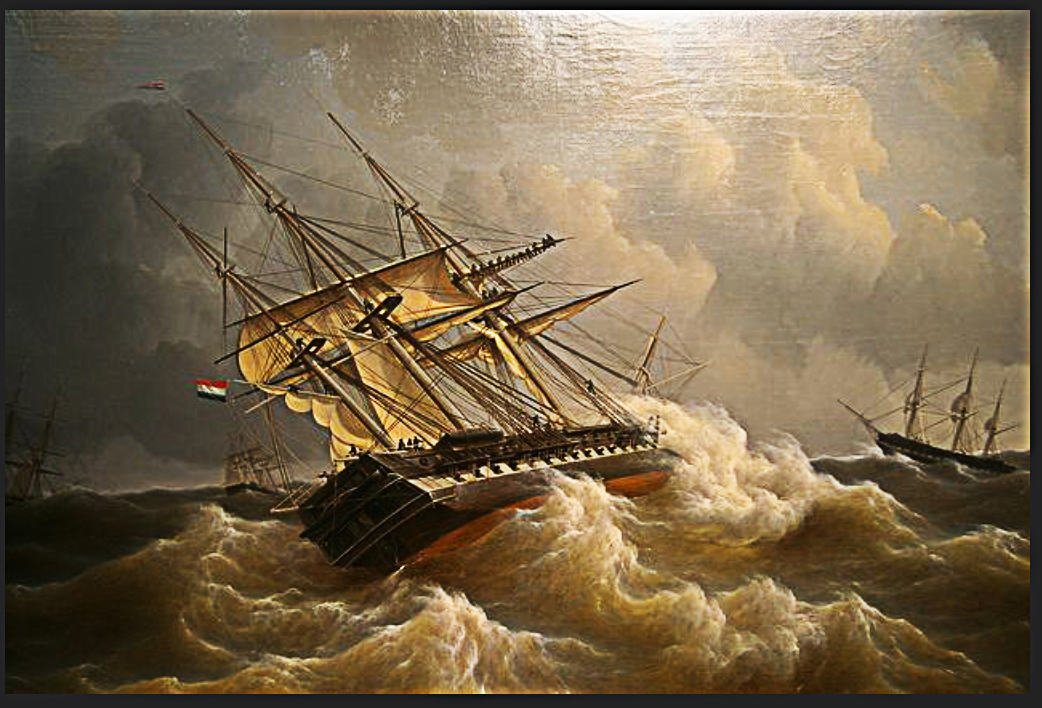
Trivia
● What instrument is used to measure atmospheric pressure?
Answer to Trivia
READ MORE: Encyclopedia Britannica
● Martha Jane Canary was a sharpshooting frontierswoman better known as?
Answer to Trivia
READ MORE: Biography
● Gray, blue, bowhead and finback are varieties of what?
Answer to Trivia
READ MORE: World Wildlife.org
● Moved by a desire to help people, Vincent van Gogh left art to become what?
Answer to Trivia
READ MORE: Biography
● What Shakespeare play if “All the world's a stage”?
Answer to Trivia
READ MORE: Shakespeare.MIT.edu

A Test for People Who Know Everything
From the Jeopardy Archives Category - “WEAPONS OF THE WAR” ($200)
“An artillery piece called the ‘Swamp Angel’, which shelled Charlestonl.”
Answer to Jeopardy READ MORE: History Channel
From the Jeopardy Archives Category - “WEAPONS OF THE WAR” ($400)
“Mitsubishi Zeros & Panzer VI Tigers.”
Answer to Jeopardy READ MORE: History Channel
From the Jeopardy Archives Category - “WEAPONS OF THE WAR” ($600)
“Big Bertha howitzers & Sopwith Pups.”
Answer to Jeopardy READ MORE: History Channel
From the Jeopardy Archives Category - “WEAPONS OF THE WAR” ($800)
“F-86 Sabres & MiG-15s, which dueled over ‘MiG Alley’.”
Answer to Jeopardy READ MORE: History Channel
From the Jeopardy Archives Category - “WEAPONS OF THE WAR” ($1,000)
“The USS Massachusetts & the Cristóbal Colón, which exchanged fire outside Santiago de Cuba.”
Answer to Jeopardy READ MORE: History Channel

Joke of the Day

Green's Gourmet Grocery
A customer at Green's Gourmet Grocery marveled at the proprietor's quick wit and intelligence.
“I wouldn't share my secret with just anyone”, Green replies.
Lowering his voice so the other shoppers won't hear.
“But since you're a good and faithful customer, I'll let you in on it. Fish heads. You eat enough of them, you'll be positively brilliant.”
“You sell them here?” the customer asks.
“Only $4 apiece”, says Green.
The customer buys three.
A week later, he's back in the store complaining that the fish heads were disgusting and he isn't any smarter.
“You didn't eat enough”, says Green.
The customer goes home with 20 more fish heads.
Two weeks later, he's back and this time he's really angry.
“Hey, Green”, he says, “You're selling me fish heads for $4 apiece when I can buy the whole fish for $2. You're ripping me off!”
“You see?” says Green. “You're getting smarter already!”







































